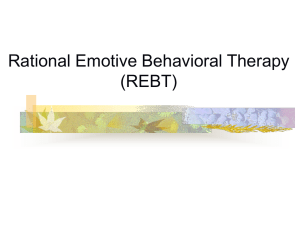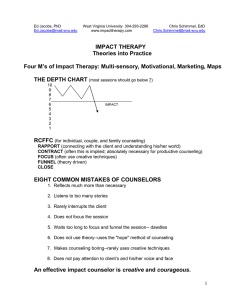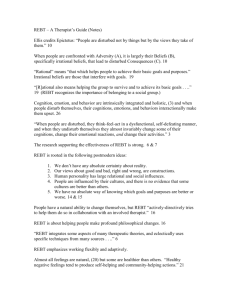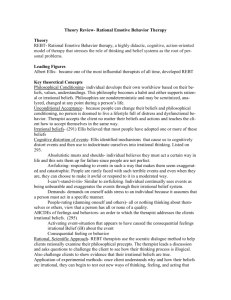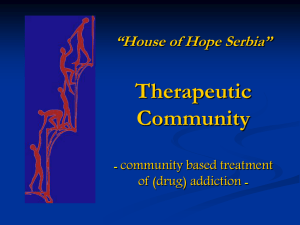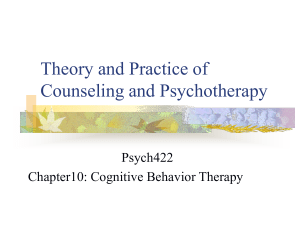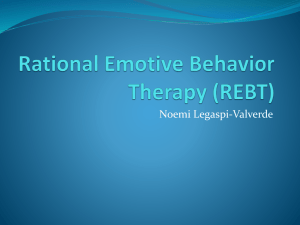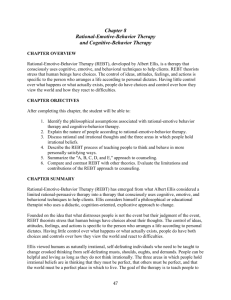Theory and Practice of Counseling and Psychotherapy
advertisement
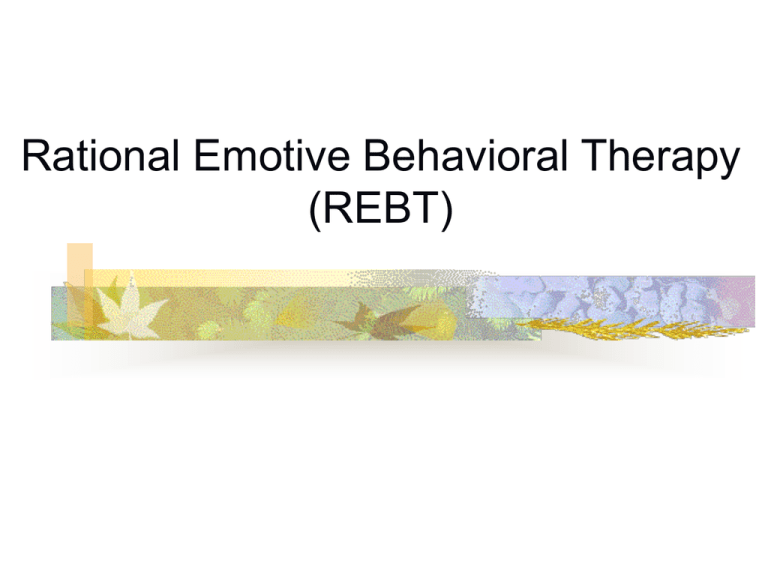
Rational Emotive Behavioral Therapy (REBT) View of Human Nature: human beings have both ___________ and __________________ are ________________ and __________________ have a tendency toward __________and ________ keep ourselves disturbed through ______________ have _____________ to change cognitive, emotive, and behavioral processes Key concepts in REBT Stresses __________, ____________, _________, and _____________ Assumes that _________, _________, and ________ interact to have a causal effect relationship Is a highly _______________________ approach concern ____________ and _______________ Emotions are mainly generated by our ______, ____________, _____________, and __________ to life situations View of Emotional Disturbance We learn _____________________ from _______________________ during childhood Teach clients to feel un-depressed even when they are __________ and ______________ by significant others. ___________________ emotional disturbances Irrational idea ______________ self-defeating We have a tendency to make ourselves emotionally disturbed by _______________________________ The A-B-C theory of personality Case discussion 1 Tom, a college sophomore, wants to overcome his shyness around women. He does not date and tries his best to keep away himself from women because he is afraid they will reject him. However, he wants to change this pattern. Using A-B-C-D-E-F to analyze and help Tom Case discussion 2 Mary would like to take a course in creative writing, but she fears that she has no talent. She is afraid of failing, afraid of being told that she is dumb, and afraid of following through with taking the course. Using A-B-C-D-E-F to analyze and help Mary Case discussion 3 Brent feels that he must win everyone’s approval. He has become a “super nice guy” who goes out of his way to please everyone. Rarely does he assert himself, for fear that he might displease someone who in turn would not like him. What are Brent’s possible irrational beliefs? How do you help Brent? If Brent is Asian American, what cultural components might you take into account? Irrational Ideas Irrational ideas lead to ___________________________________ Some examples: “I must have love or approval from all the significant people in my life.” “I must perform important tasks competently and perfectly.” “If I don’t get what I want, it’s terrible, and I can’t stand it.” Therapeutic Goals Minimize ____________________________ Decrease ___________________________ Become more _______________________ Acquire unconditional ______________ and unconditional _____________________ Think __________, feel __________, and act more ______________ in achieving the goals of living happily Therapist’s function and Role Discover clients’ ______________________ Make connection of how ________________ lead to ______________________ Modify clients’ _______________________ Dispute __________________ and substitute ________________________ _____ spending too much time on exploring clients’ ________________ The Therapeutic Relationship The therapeutic relationship is important, but ________________________ is not required. Therapists show great faith in their clients’ ability to ______________________________. Therapists ______________ their own _____________to clients Therapeutic techniques--Cognitive methods Disputing irrational beliefs Writing cognitive homework Changing one’s language Cost-benefit analysis Therapeutic techniques--Emotional Methods Rational-emotional imagery Role playing Shame-attacking exercises Forceful self-dialogue Therapeutic techniques--Behavioral methods Activity homework Reinforcements and penalties Skill Training Research on REBT More than __________studies Most research on _____________________ Review of outcome studies: REBT was more significantly more effective than other therapies or control group in 31 of 47 studies (DiGiuseppe & Miller, 1977) and in 49 of 89 studies (Silverman, McCarthy, & McGovern, 1992). Research Efforts Most studies focus only on __________methods Summary and Evaluation: contributions focus on how we ____________ and _________________ events put insight into _________________ teach clients how to be ______________________________ Summary and Evaluation: Limitations too ______________________ ignoring the _________________ ________________ imbalance (teacher-student)
